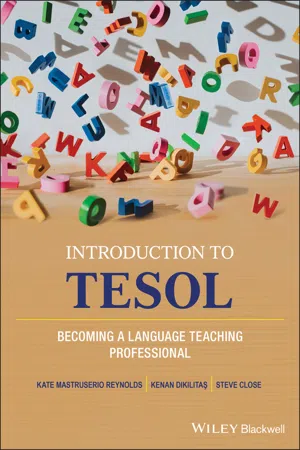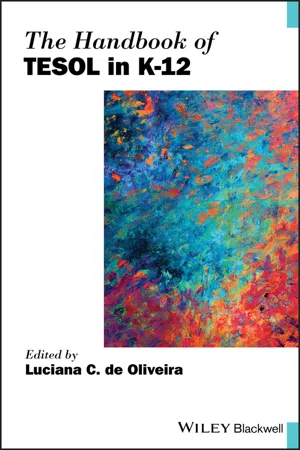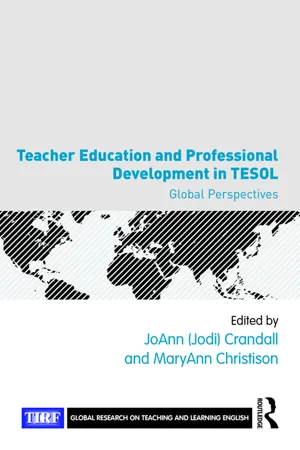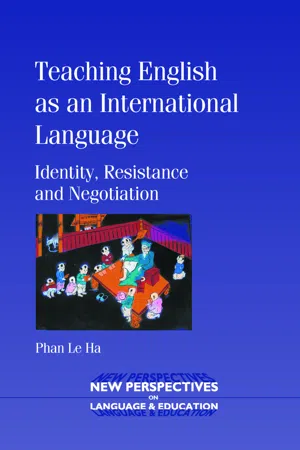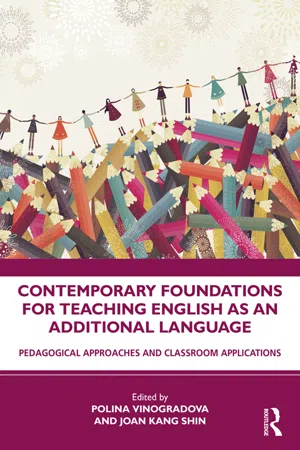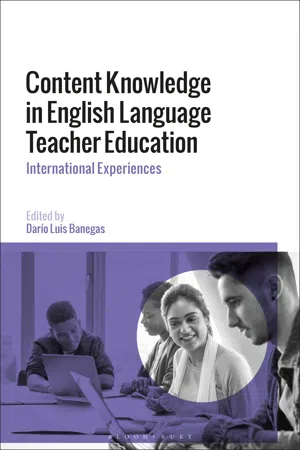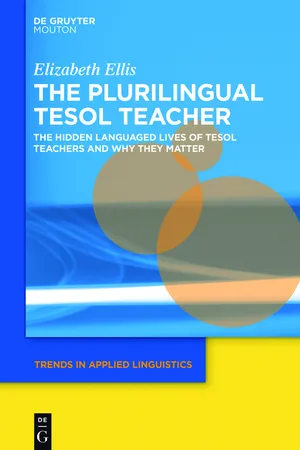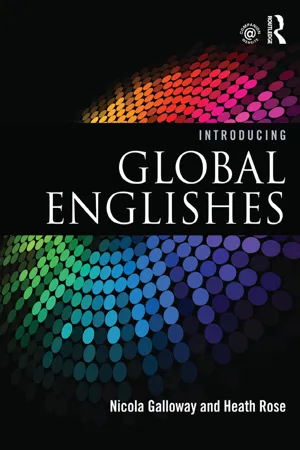Languages & Linguistics
TESOL
TESOL stands for Teaching English to Speakers of Other Languages. It refers to the field of education that focuses on teaching English language skills to non-native speakers. TESOL encompasses various teaching methods, language acquisition theories, and cultural considerations to effectively instruct individuals in English language proficiency.
Written by Perlego with AI-assistance
Related key terms
Related key terms
1 of 4
Related key terms
1 of 3
9 Key excerpts on "TESOL"
- eBook - ePub
Introduction to TESOL
Becoming a Language Teaching Professional
- Kate Mastruserio Reynolds, Kenan Dikilitas, Steve Close(Authors)
- 2021(Publication Date)
- Wiley-Blackwell(Publisher)
Part One The Field of TESOLPassage contains an image
1 What Is TESOL?
This chapter will introduce TESOL as a field showing the various contexts and populations for English language instruction. It will highlight the domains that provide insight into how to teach, assess, and research in English as a second language. This chapter will provide basic acronyms needed by English language instructors in TESOL to situate their work and learn more about it. Proficiency levels, which describe levels of language development, will be presented. Finally, the interdisciplinary nature of TESOL and specializations within the field will be discussed.Learning Outcomes
At the conclusion of this chapter, you will be able to:- compare and contrast the unique attributes of different contexts of English language learning
- define common acronyms in the field
- apply knowledge of proficiency levels to lesson planning, delivery, and instruction
- connect the disciplines that inform the study of second/additional language learning
- describe the interdisciplinary nature of TESOL
- discuss the specializations of professionals in the field
In this vignette, you will read about two locations where English is taught and how the context influences the instruction. Observe the differences and reflect upon how you envision your future English language teaching or which example mostly closely aligns with your current instructional setting and practices.TESOL Voices
Diverse Learners, Diverse Settings
In Kobe, Japan at Aitoku Gakuen Junior/Senior High School, uniformed ninth-grade students enter their English as a foreign language (EFL) class. Both the teacher, who speaks Japanese and English, and the teacher assistant, a native English speaker from Australia, greet the students in English as they enter the classroom. The teacher prepares her lesson by arranging the necessary paperwork and bringing up a video about air pollution in Japan. The teacher assistant engages the students in casual social conversation about how they feel, how their weekend was, and what they are up to personally. The students seem a bit embarrassed, but try to respond to the questions as well as they can. Some students respond in full sentences and provide some details about their lives; others provide one-word answers and look down to avoid more questions. Once the teacher begins the class, she reviews the meanings of the key vocabulary they are learning. Students provide definitions and examples of the vocabulary during a quick game, competing to see how many their team can get correctly in 2 min. After the vocabulary review, the students watch an 8-min video in English on air pollution in Japan. While they watch, they are asked to identify key information presented in the video. Next, they individually read an article about air pollution in English. Some students raise their hands to ask questions about a word or phrase and the teacher or teaching assistant approaches them to answer quietly. The teacher leads the whole class in discussion about the article by asking comprehension and opinion questions. She says, for example, “What is the greatest cause of air pollution today? How do you think you can reduce air pollution?” Students raise their hands to respond and several contribute their ideas of how they can reduce air pollution. Then, the teacher gives them a group project to investigate more ways people can reduce air pollution. Students are given small posters to describe and illustrate with their findings. Students will present their posters to the class. - eBook - ePub
Success on your Certificate Course in English Language Teaching
A guide to becoming a teacher in ELT/TESOL
- Caroline Brandt(Author)
- 2006(Publication Date)
- SAGE Publications Ltd(Publisher)
However, ELT/TESOL as a field is not limited to the teaching and learning of ESOL. It encompasses a wide range of related activities, including for example:- development and administration of internal tests, such as those needed to place students in a language programme or to assess progress
- development and administration of national and international examinations and tests of proficiency, including those such as TOEFL (the Test of English as Foreign Language) and IELTS (the International English Language Testing System)
- development and publication of materials and textbooks for class use and for teachers’ reference
- owning and managing private language schools
- management and administration of departments within schools, colleges and universities
- training and development of English language teachers at all stages: pre-certificate, certificate, diploma, Masters, Ph.D.; and for specializations such as EAP or Young Learners
- training of ELT/TESOL trainers or tutors
- moderation and assessment of teacher training courses such as those validated by Cambridge ESOL and Trinity College London
- management and promotion of international associations such as IATEFL and TESOL
- organizing and running conferences, seminars and workshops
- research and publication of journals and research papers
- publication of newsletters and magazines for teachers and language learners
- design and operation of websites including chat rooms and discussion forums
- recruitment
- marketing and promotion of courses and materials.
LINGUISTICS, APPLIED LINGUISTICS AND ELT
Linguistics - eBook - ePub
- Luciana C. de Oliveira, Luciana C. de Oliveira(Authors)
- 2019(Publication Date)
- Wiley-Blackwell(Publisher)
2018 ) found that MA TESOL programs share much in common in terms of core knowledge based in SLA research, there are strengths of some programs and regions that are not always shared across the TESOL community of practice. For instance, while in the United States supervised practica are an essential component of TESOL specialist preparation, this may not be the case in programs in other parts of the world. Three broad considerations we offer to TESOL specialist programs are (a) a move to a more globalized understanding of the profession of English language teaching, (b) a greater connection to bilingual and translanguaging approaches in ESL classrooms, and (c) an enhanced recognition of TESOL specialists as teacher leaders. Important considerations for each of these future directions is outlined in this section.Globalizing the Education of TESOL Specialists
At the same time that TESOL teacher preparation responds to local staffing needs, teacher educators likely want to prepare candidates to enter into the wider field of TESOL. This in large part depends on awakening in students a consciousness about the role of English in world contexts, where it may be a lingua franca, an International Language, and both taught and used by “non‐native” speakers. The heritage of English as a colonizing force and a broader awareness of the role of TESOL specialists in a range of settings can enhance teachers' intercultural competence, develop more globally‐informed and critical perspectives on education, and improve their foreign language and teaching skills. Stapleton and Shao (2018 ) note anapparent lack of course offerings in MATESOL programs worldwide that address the classroom realities of international TESOL students whose mother tongue is not English. As a case in point, courses that provide strategies for prospective teachers on how to cope with learning environments, such as those containing curriculums with mechanics‐focused approaches and summative assessment, appeared to be largely absent in our data, yet such courses would certainly fill a need. (p. 26)Establishing Stronger Connections to Bilingual and Translanguaging Approaches
Moving away from more traditional models that separate the native language and English during instructional time is another challenge facing the TESOL specialist in K‐12 contexts. In distancing itself from the “two solitudes” (Cummins, 2008 , p. 1528) model of allowing students to use one language during one part of the day or during certain content‐area instruction, and then allowing them to use another language during another part of the day or content‐area, inaccurately represents the ways in which bilinguals actually use language and for which purposes. For example, Bunch (2014 , p. 70) suggests delineating a language of “ideas” versus a language of “display,” wherein academic language is reconceptualized so that students can think and process using the language resources of their choice, and then display their thinking in another. Translanguaging approaches, or those pedagogical practices that enable ELs to access and use their entire linguistic repertoire at any time during school, may in fact promote bilingual identity and improve student performance (Creese & Blackledge, 2010 ; García, 2009 ). When TESOL specialists can model dynamic bilingual language practices, position and celebrate their students as bilingual rather than as simply defining them in terms of English learning, and draw specific attention to language crossing, they have a greater chance of leveraging ELs' bilingual resources in the classroom (Palmer, Martínez, Mateus, & Henderson, 2014 - eBook - ePub
Teacher Education and Professional Development in TESOL
Global Perspectives
- JoAnn Crandall, MaryAnn Christison(Authors)
- 2016(Publication Date)
- Routledge(Publisher)
III Second Language Teacher Education for Diverse ContextsPassage contains an image
5 Diversity within TESOL Teacher Education Programs
Ali Fuad Selvi and Megan Madigan Peercy DOI: 10.4324/9781315641263-5What does it mean to be and become a teacher of English? This simple question has challenged and intrigued teacher educators for many decades and has urged them to rethink some of the most fundamental assumptions regarding teaching and teacher education. The increasing linguistic, cultural, and geographic diversity among English language learners (ELLs), especially in North America, has underscored the critical importance of equipping teachers with knowledge, skills, and dispositions to individualize planning, instruction, and assessment for a variety of student backgrounds and needs (Genesee & Harper, 2010 ). As a result, the notion of diversity functions as a common thread running through many professional benchmarks, standards, and statements in teacher education (e.g., AACTE, 2015 ; edTPA, 2015 ; Guyton & Byrd, 2000 ; TESOL/CAEP, 2010 ), and serves as a driving force that is reshaping teacher educational practices (Cochran-Smith & Zeichner, 2005 ; Darling-Hammond & Bransford, 2005 ; Villegas & Lucas, 2002 ).Motivation for the Research
Because of the dynamic nature of TESOL and second language teacher education (SLTE), it is difficult to generate sustainable models and programmatic structures. In addition, the task of creating viable responses has become even more challenging due to two important trends: (1) the exponential growth in diversity among ELLs and their teachers and (2) the recent calls for reconceptualizing the epistemological orientation of SLTE. The growth in diversity in SLTE is operationalized at various levels, including ethnic and racial (Curtis & Romney, 2006 ; Kubota & Lin, 2009 ), religious (Wong & Canagarajah, 2009 ), linguistic (Adamson, 2005 ; Valdes, 2006 ), intercultural (Corbett, 2003 ; Deardorff, 2009 ), and dialectal/variational (Crandall, 2003 ; Jenkins, 2014 ; Kachru & Smith, 2008 ). Recent epistemological orientations for SLTE construct teacher learning and thinking as situated in social contexts (Johnson, 2006 ; Johnson & Golombek, 2011 ; Zuengler & Miller, 2006 ). Collectively, these efforts redefine our inherent assumptions regarding the sociocultural and linguistic contexts of teaching, learning, and teacher education. Consequently, they underscore the urgency of examining divergent realities afforded by SLTE programs (Ramanathan, Davies, & Schleppegrell, 2001 ) in preparing the teacher workforce for both ESL and EFL contexts (Govardhan, Nayar, & Sheorey, 1999 - eBook - ePub
Teaching English as an International Language
Identity, Resistance and Negotiation
- Phan Le Ha(Author)
- 2008(Publication Date)
- Multilingual Matters(Publisher)
To begin with, let me take a look at Liu’s (1998) study, which has raised valuable points regarding this issue. He criticises the ethnocentrism in TESOL courses in NABA (North America, Britain and Australia) as neglecting the ‘needs of international TESOL students’ (p. 3). First, such neglect has been seen in ‘L2 acquisition theories and TESOL methodologies’ (p. 4), where little consideration of other non-NABA contexts has been taken into account, and this may result in ‘impractical or ineffective’ (p. 4) adaptation of teaching methodologies in non-NABA countries. Accordingly, ‘NABA TESOL teacher education may do international TESOL students a great disservice’ (p. 6). Second, ‘language improvement’ (p. 7) is regarded as another area receiving insufficient attention. Few TESOL programmes pay specific attention to international TESOL students’ language needs, because the focus of TESOL programmes is on ‘enhancing students’ explicit knowledge of the language, rather than their ability to use it’, and thus it ‘usually fails to meet [their] needs” (p. 7). This obviously disadvantages these students by broadening the gap between native and non-native teachers of English. Third, those students are believed not to achieve ‘cultural understanding’ (p. 8) in their NABA TESOL courses, since their ‘exposure is often confined to campus culture’ (p. 9). Liu suggests ‘a systematic study of culture via a course or research project’ (p. 9) should be embedded in TESOL courses. He supports this suggestion by stating that ‘studying another culture does not mean embracing it or following its socio-cultural customs, nor does it mean losing one’s own culture’ (p. 8).Brown (2000: 227) also explores ELT teacher training and reveals some conflicts between contemporary ELT, ‘particularly but not exclusively in the “importing” of new techniques associated with communicative language teaching’ and the reality of implementing such techniques in developing countries. He argues that ‘cultural continuity’ (p. 227) and gradual changes should be ‘respected, by not losing contact with current [local] practice’ (p. 227).Edge (1996) expresses his concerns about cross-cultural paradoxes in TESOL. As a native teacher of English in Britain, Edge feels that the TESOL industry has been advocated along the lines of ‘the “greed is good” governmental [British] philosophy’, and hence it results in ‘a cross-cultural clash, a conflict of values at the heart of society’ (p. 14). The first paradox refers to the ‘sociopolitical context’; Edge believes that the TESOL culture has made teachers and students heavily dependent on ‘the dominant social-market perspective’ (p. 14), and thus the question of value is challenged. The second paradox is called ‘liberation and domination’ (p. 16). Edge explains that TESOL liberates but also dominates the Other everywhere, opens doors to some yet kicks others out. ‘Foundations and fundamentalism’ is the third paradox (p. 20), and this refers to ‘respect for the right to be different’ (p. 21). Edge acknowledges that although the Centre’s TESOL culture has not refused to take action to react to any challenge it may encounter, whether at home or overseas, it has still failed to respect others’ values. - eBook - ePub
Contemporary Foundations for Teaching English as an Additional Language
Pedagogical Approaches and Classroom Applications
- Polina Vinogradova, Joan Kang Shin, Polina Vinogradova, Joan Kang Shin(Authors)
- 2020(Publication Date)
- Routledge(Publisher)
The teaching profession is a lifelong learning experience; thus, teacher education and development goes beyond undergraduate or graduate programs in TESOL or language education. It includes continuous and regular professional development of in-service teachers in the form of professional discussion groups, professional associations, and professional development workshops and programs. For the purpose of this chapter, I focus specifically on academic preparation of TESOL candidates and discuss concepts and practical implications with this teacher population in mind. At the same time, these concepts and considerations are applicable and important in professional development of in-service English language educators as well.CONCEPTS AND THEORETICAL CONSIDERATIONS
If we think about TESOL programs, we often envision a great diversity of students and environments. In some programs, students come from various places around the world, planning and getting ready to go and teach around the world; many are going to places which might not be where they came from or socioculturally familiar to them. In others, still quite diverse, there are students sharing a common local knowledge, having a common cultural framework, and expecting to teach students in settings rather familiar to them. What are the principles and knowledge that TESOL candidates need to be exposed to and explore in order to be teaching professionals who are able to research, explore, and understand the nuances of their teaching settings?In this chapter, I focus on aspects that define contemporary teacher education and that can enable teacher candidates and practicing teachers to implement critical, culturally responsive pedagogy that creates space for translingual multimodal practices, views literacy as multilingual and multimodal, and recognizes advocacy as an essential component of teaching and professional development.EL Teacher Expertise
A substantial part of teacher preparation and professional development undoubtedly focuses on the development of teacher expertise. But what does this expertise mean in the postmethod era when we need to prepare TESOL candidates to implement critical participatory pedagogy? Following Farrell (2013) and Johnson (2006), we can suggest that EL teacher expertise has historically included learning about the subject of teaching, in our case English; learning about teaching methods or, in postmethod terms, professional theories; observing and practicing professional theories through microteaching and practicum activities; and developing pedagogical expertise during the first years of teaching. Thus, from being a novice teacher, we observe a gradual movement toward developing expertise that Farrell (2013) views as both a state and a process. Expertise as a state refers to teacher’s knowledge after years of teaching, while expertise as a process describes teacher’s development over time. Johnson (2006) further expands on the development aspect of teacher expertise and describes teacher learning as - eBook - ePub
Content Knowledge in English Language Teacher Education
International Experiences
- Darío Luis Banegas, Darío Luis Banegas(Authors)
- 2020(Publication Date)
- Bloomsbury Academic(Publisher)
5 Multiple Languages in a TESOL Course T. Leo Schmitt IntroductionThe New School’s MA TESOL programme is a thirty-credit curriculum that prepares students to be able to teach English as a second/foreign/new language to adults in a wide variety of circumstances. It promotes a socially conscious approach to teaching with an emphasis on issues of social justice in the classroom. Students are encouraged to not only become familiar with various paradigms and teaching methodologies but also to build and expand their own approaches to teaching based on their own strengths and beliefs, their institutional expectations, and in particular their needs. Such flexibility in the many potential educational contexts is a hallmark of New School MA TESOL graduates. Students can complete the degree entirely online, entirely on site in New York City, or in a combination of online and onsite courses. Students come from around the world and from a diverse mix of personal and professional backgrounds.The linguistic analysis courses form a core part of the New School’s MA TESOL programme. The two linguistic analysis courses (Language Analysis for Teachers: Phonology, Lexis, and Syntax and Language Analysis for Teachers: Grammar and Discourse) are required of all graduates and aim to provide students with a fundamental understanding of the basic linguistic building blocks of language, including phonology, morphology, syntax and discourse. These courses support the other courses in the programme that address pedagogy by giving students the conceptual framework, as well as the metalanguage, necessary to understand how language is formed and how it can be analysed and examined. While an entire review of all of the idiosyncrasies of English would be beyond the scope of a two-semester sequence, students should gain the tools necessary to be able to approach any linguistic question intelligently, analytically and critically. They should also gain the ability to explain these features to learners when and if appropriate. - eBook - ePub
- Elizabeth Ellis(Author)
- 2016(Publication Date)
- De Gruyter Mouton(Publisher)
Together with the examination of entry standards and teacher education content, this discussion has shown how TESOL has developed as a profession which pays little heed to teacher second language proficiency or teacher second language learning, or, in other words, which has a monolingual perspective. Finally, by examining statements of competency, and comparing them with those of other countries, it has demonstrated an international recognition that TESOL teachers need certain knowledge, skills and attitudes in order to be competent practitioners. It will be shown in Chapter 8, in a review of the teacher cognition literature, that knowledge and beliefs are crucial in any attempt to understand teacher competence. This book sets out to establish how language learning experience may contribute to the knowledge and beliefs which are clearly seen as desirable by the international profession. The research questions which form the basis of the three studies on which this book is based, then, are as follows. Research questions 1. Does the language learning experience of teachers of TESOL to adults contribute to their professional knowledge and beliefs? 2. If so, what kinds of language learning experience make a contribution and in what ways? Vignette 2 – Stan My experience of language learning definitely influences the way I teach Stan is a native English speaker (NS) who has been teaching English in Japan for thirteen years. He grew up in a monolingual English family in the West Country of England, and having learned several languages in various ways, has both elective and circumstantial plurilingual experiences. Early on he became aware of different attitudes to Standard English and the local dialect: we had quite a strong dialect. . - eBook - ePub
- Nicola Galloway, Heath Rose(Authors)
- 2015(Publication Date)
- Routledge(Publisher)
There is already a large talent pool and about 80 per cent of the English teachers worldwide are non-native English-speaking teachers (Braine, 2010, p. x). Two ‘position statements’ by the International Association Teachers of English to Speakers of Other Languages (TESOL, 1992, 2006), opposing employment discrimination based on the native/non-native distinction, suggest that things are changing and the TESOL organization’s Non-Native English Speakers in TESOL Interest Section (see http://nnest.asu.edu/), which stemmed from a caucus started in 1998, shows increasing attention to these issues at the scholarly level. ‘However, the tenet that the ideal teacher is the native speaker remains resilient, even in multilingual settings, where the major role of English is as a lingua franca’ (Kirkpatrick, 2012, p. 133). Summary of proposals The arguments put forward here reflect a very different concept to traditional ELT. The proposed changes are summarized in Table 9.1, where traditional ELT is contrasted with GELT, a more Global Englishes approach to language teaching. GELT focuses on diversity and the function of English as an international lingua franca, rather than traditional approaches to ELT which aim to teach people to speak with native English speakers. A GELT approach acknowledges that the ‘owners’ are ELF users and the target interlocutors are other ELF speakers, as well as native English speakers. As a reflection of this, a GELT approach would promote the recruitment of teachers from around the world, with a focus on multilinguals with ELF experience rather than monolinguals with no ELF experience. Likewise, ‘norms’ would centre on diversity and flexibility, and on the development of strategies to interact with people from many different backgrounds
Index pages curate the most relevant extracts from our library of academic textbooks. They’ve been created using an in-house natural language model (NLM), each adding context and meaning to key research topics.
Explore more topic indexes
Explore more topic indexes
1 of 6
Explore more topic indexes
1 of 4
